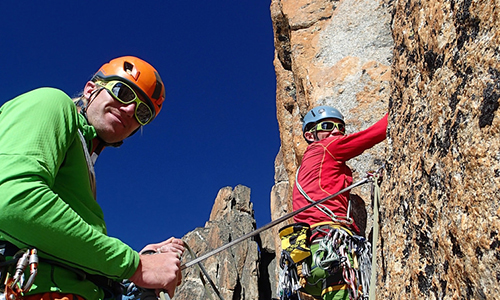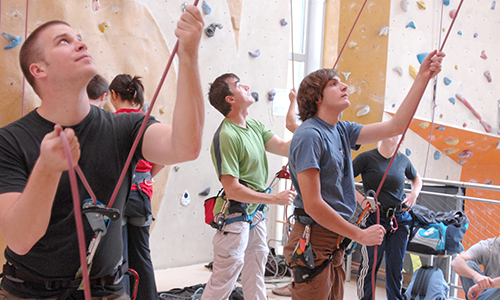Tips to Be a Pro in Belaying
 Rock Climbing is one of the best outdoor sports for adventure freaks. However, to be an adept rock climber one needs to be aware of not just the right techniques but proper training as well.
Rock Climbing is one of the best outdoor sports for adventure freaks. However, to be an adept rock climber one needs to be aware of not just the right techniques but proper training as well.
Apart from teaching their pupil how to climb with precision, the professional trainers also introduce to them the skill of belaying. Belaying is a foundational skill that is essential to be acquainted with before trying your hand at rock climbing. The climber and the belayer must work in unity. Both depend on each other during their rock wall ascension. They are connected via climbing rope. Additionally, a belay device is recommended by the trainers. Having undergone a full-fledged rock climbing training that included teaching types of belay alongside additional climbing fundamentals. Let me share my experience of rock climbing and belaying which shall include the key steps in learning how to top-rope belay.
The first of the steps in this training is:
Gearing Up
Any training session of rock climbing and belaying includes the need of basic mandatory gear. You need a climbing rope, helmet, harness, locking carabiners, rock shoes, belay device etc., to carry on with the climb. There are many belay devices used to save your partner from a fall or just lower them when required. 2 major belay devices are tubular and brake assist. Learning to use the devices is a task not to be ignored. There will be times when you might have practised with a completely different device during your training. Always invest in the best of the devices before heading for your first ever rock climbing and belaying.
Setting Up
Once you have the right gear with you, you need to perform a few basic steps. After tying themselves to the harness using a figure 8 knot you need to follow the steps mentioned below.
- Close the system- By knotting at the end of the rope, the rope never passes through the belay device.
- Ground anchor-Ground anchors are useful too, especially where you have a hindrance between you and the wall.
- Set belay device- The climber-rope side of the bight should always be on the top side of your belay device.
- Attach a Carabiner-This should pass through the belay device. Always lock the carabiner.
Safety Check
Always double check the equipment and gear before the start. Look out for the figure tied 8 knots, the buckles fastened or not, the belay device is threaded properly or not, and peruse through the guidebook to keep yourself updated with the terminology to communicate during the action.
Communication
Having a loud and clear voice is a blessing in disguise for any belayer. Make sure there is no scope for miscommunication between you and your climber. Else, this might result in unforeseen consequences. There are a few coded commands that make communication a lot easier. I remember them vividly as they really helped me with my rock climbing session. These are:
- ‘Take” or “Tension”- For removing slack
- Always add your partner’s name-Commands with your partner’s name in it, makes it easy for them to concur.
- “Rock”- Always look down when you hear this command. This is usually spoken by the climber in case there is something loose and about to fall.
- “Watch me”- The words when the climber feels a fall is coming.
- “Falling”- Stay alert and in position for this one!
Know the Technique Right
There is a huge difference in knowing things and implementing things. The techniques of belaying require practice and precision. There are a few pointers to remember if you are the one responsible for belaying. These are:
- Make sure your brake hands are on the rope all the time
- When the rope is firmly held in the braking position, only slide a hand
- The orientation of your brake hands in their natural position is the best thing to do
- Never lose sight of your climber and keep a check of the surroundings and the obstacles
- Have the right belay stance, i.e., always keep your non-dominant foot forward with the knees bent. This keeps you away from being directly hit by an unforeseen fall
- PBUS (pull, brake, under, and slide) technique is an effective way of managing the climb and the climber
- Coordinating with the climber and communicating with them is the ideal thing to do. Always be in sync with them
Catch the Fall
 Having good reflex actions works well for you and your partner. Keeping your eyes hooked to the climber can save a life. Always remember to:
Having good reflex actions works well for you and your partner. Keeping your eyes hooked to the climber can save a life. Always remember to:
- Keep your hand brake down when tightening the grip
- Make full use of the harness, your body, rope, and belay device to absorb the force of the fall
Remember, the climber might want to pause in the middle of their climb. During this time perform the following steps:
- Remove slack
- Pull the brake hand down
- Lean back so that the rope tension is maintained
- Communicate with the climber
The climber might even ask to lower them. In such a case:
- Keep both hands on the rope
- Let the rope feed through
- Maintain the pace and make sure you adjust the lowering as per the request of the climber
- Take a pause so that the climber can analyse if he or she is facing any other obstacle
- Give the climber a good landing on their feet by slowing down as they near the ground level
- In the end, shout out- Belay Off!
Precaution is always better than cure and it is even better when your life is at risk! Engaging in such outdoor sports is not just thrilling, but equally risky. Going for a proper training and considering few tips can help you stay a bit more confident and encouraged.

Submit a Comment